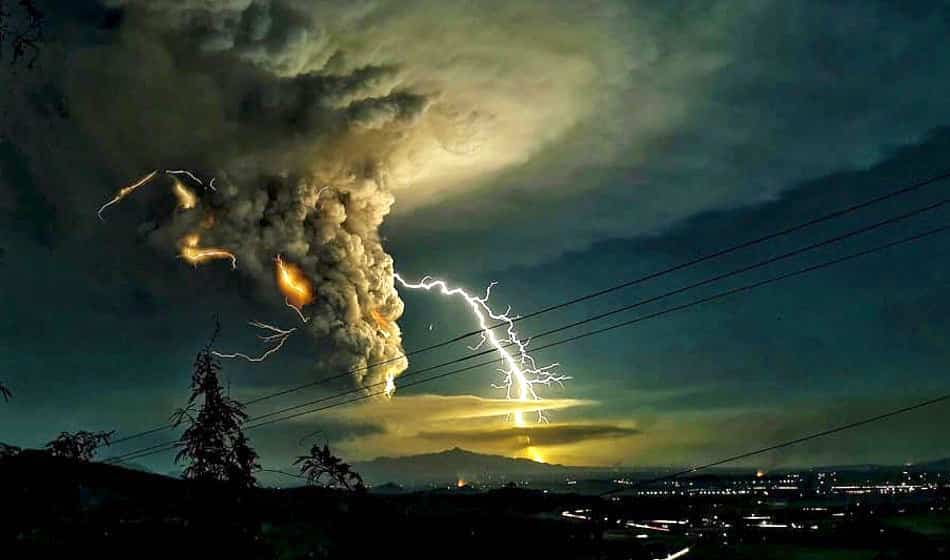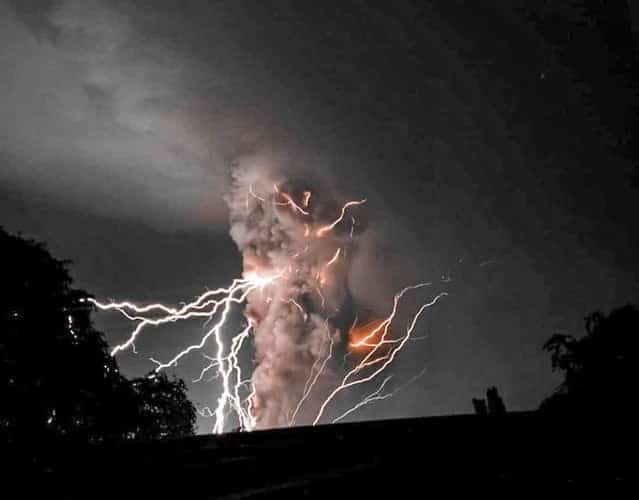On January 12, after more than 40 years of inactivity, Taal volcano (about 65km from the capital Manila of the Philippines) “awakened” and erupted again. As a result, a lot of ash was released into the atmosphere and created a giant column of smoke about 10km high, rising straight into the sky, mixed with terrifying thunder and lightning, along with the risk of a tsunami.

Residents living around the Taal Volcano area have been ordered to evacuate after the emergency alert was raised to level 4/5, meaning a hazardous eruption could occur within hours to days. On January 13, Taal Volcano began spewing red lava. According to the Philippines’ National Disaster Risk Reduction and Management Council, about 8,000 residents were evacuated from the island, with about 6,000 people out of the danger zone by the evening of January 12.
Snapshots of Taal volcano eruption.
Keep safe everyone.
pic.twitter.com/xgUjs1ZXhX
— shuajo
(@joshibob_) January 12, 2020
If you're mesmerized by the steamy #Taal eruption plume and wondering why it's creating so much #VolcanicLightning, you’re not alone. Here’s a micro-crash course on the physics of volcanic thunderstorms for non-specialists. Thanks to @joshibob_ for the incredible footage! (1/14) pic.twitter.com/CCl6zw56RZ
— Alexa Van Eaton (@volcaniclastic) January 13, 2020
However, according to Sonja Behnke, a volcanologist at the Los Alamos National Laboratory (USA), the phenomenon of lightning striking a volcano, also known as volcanic lightning, is not uncommon. In fact, she has witnessed this phenomenon many times in places such as Iceland and Japan.
So how does volcanic lightning form?
First, volcanic ash needs to be electrically charged. When a volcano erupts (as opposed to a mild lava eruption like the one that happened in Hawaii), it shoots molten rock particles (called “magma”) into the air, creating volcanic ash.
In these ash columns, billions of magma particles begin to collide, rubbing against each other, creating charged particles. The process is similar to creating an electrical charge by rubbing a sock on a carpet. “The ash gets charged when the volcano erupts,” says Sonja Behnke.
“Both volcanic lightning and thunderstorm lightning are basically caused by particle collisions,” says atmospheric scientist Adam Varble, a thunderstorm researcher at the Pacific Northwest National Laboratory. In storm clouds, it’s just ice particles hitting each other to create electrical charges, whereas volcanic lightning is caused by magma particles rubbing against each other.
Then, to get the lightning, the charged particles need to separate into different regions in the volcanic ash plume. In a turbulent ash plume, particles of different sizes fall at different speeds, creating regions of different charges—either positive or negative.
When there are two regions of oppositely charged particles, the space between them becomes an electric field, allowing electricity to travel through the air. This is how lightning bolts form in volcanic ash or storm clouds.
Dramatic video shows bolts of lightning as a volcano spews ash up to nine miles into the air in the Philippines.
The country has raised the alert level, meaning an "explosive eruption" could happen in the coming hours or days: https://t.co/28tNsT07uQ pic.twitter.com/VV04MoFDQR
— CNN (@CNN) January 13, 2020
Lightning (in volcanoes or storm clouds) is very powerful, carrying a charge of billions of volts.
Taal Volcano has produced a lot of lightning. This is probably because the particles fly very high into the air and then freeze and become watery. This means that the charged particles are both magma and ice, which causes the lightning to appear in the Taal volcano’s ash plume.
In fact, Taal Volcano has erupted more than 30 times in the past 5 centuries, most recently in 1977. In 1911, an eruption killed 1,500 people, and the eruption in 1754 lasted for months. Although this caused many people to evacuate, it also attracted the attention of tourists because of the rare and majestic sight.






